Gargoyle Geckos, also known as New Caledonian Bumpy Geckos, are found deep in the island of New Caledonia.
Their natural habitat is tropical and very humid. As a semi-arboreal species, this breed mainly feeds on fruits, nectars and insects.
The term “Gargoyle” comes from the bumps that rest on these lizards’ heads.
Like most other geckos, these reptiles come in earthy shades with many distinctive patterns and morphs.
The Gargoyle Gecko is a medium-sized lizard and makes the ideal first reptile for novice owners. They are very easy to care for and become very accustomed to human handling.
Though these lizards are able to regenerate their tails, there is a common misconception that they will automatically drop their tails if you tug on it. This is simply a myth because they will only autotomize if they feel fear.
Continue reading if you’d like to learn more about this lizard and how-to care for them.
What Is A Gargoyle Gecko?
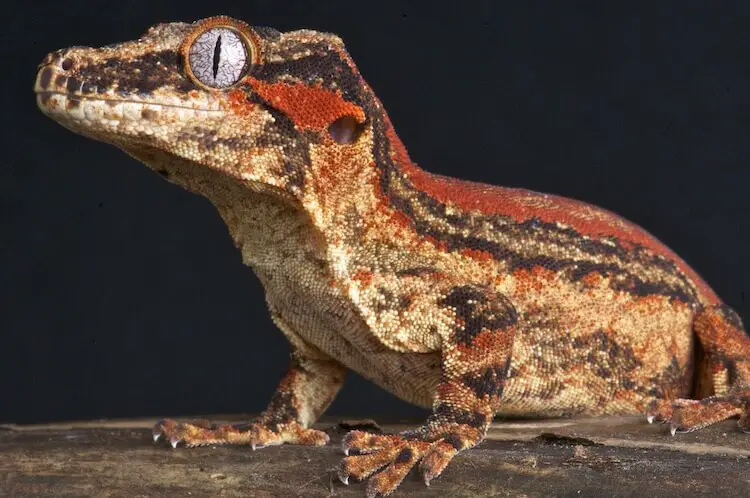
The Gargoyle Geck was first discovered in 1869.
Like many popular Geckos, New Caledonian Gargoyle Geckos are native the island New Caledonia. They are tree-dwellers that typically live in moist, maquis habitats (i.e. dense vegetation) .
This reptile comes in many different colors such as brown, white and red. They may also have distinguishing spots and stripes (e.g. orange and yellow). These Geckos have big round eyes, a triangular-shaped head and a stocky body.
Their most unique feature are the cranial bumps on their head that resemble those of a Gargoyle’s.
Other characteristics include thin, regenerative tails and small toe pads. Their tiny toe pads still give them the ability to be semi-arboreal.
The scientific name for this lizard is Rhacodactylus Auriculatus. All Geckos from the Rhacodactylus family originate from New Caledonia and are medium or large in size.
Owners love these geckos because they are very docile and amusing to watch. Since they are nocturnal, they are very active at night and might even make noises such as squeaks or low growls.
Gargoyle Geckos are popular because they are widely available and easy to care for. They are the perfect reptiles for beginners:
- These geckos aren’t too picky with their housing; the most important factor is that their humidity and temperature requirements are met (see housing section below).
- They are omnivores and will happily live off a diet consisting of meal replacement and insects.
- Maintaining a healthy Gecko is fairly easy as long as you satisfy your Gecko’s nutrient and humidity needs.
- These Geckos are known to have a docile, friendly temperament. In terms of behavior, they are nocturnal and won’t be active until the nighttime.
| Lizard Quick Facts | |
|---|---|
| Common Names | New Caledonian Bumpy Gecko |
| Scientific Name | Rhacodactylus Auriculatus |
| Adult Size | 8-10 inches, 60-80 grams |
| Lifespan | 15-20 years |
| Diet | Fruit, insects, and small rodents |
| Tank Size | At least 12 by 12 by 18 inches or 20 gallons. The tank should be taller than wider because they are semi-arboreal |
| Humidity & Temperature | 77-84°F and humidity should be kept between 50-70% |
| Popular Alternatives | Leachie Gecko, Crested Gecko |
Gargoyle Geckos Care Guide
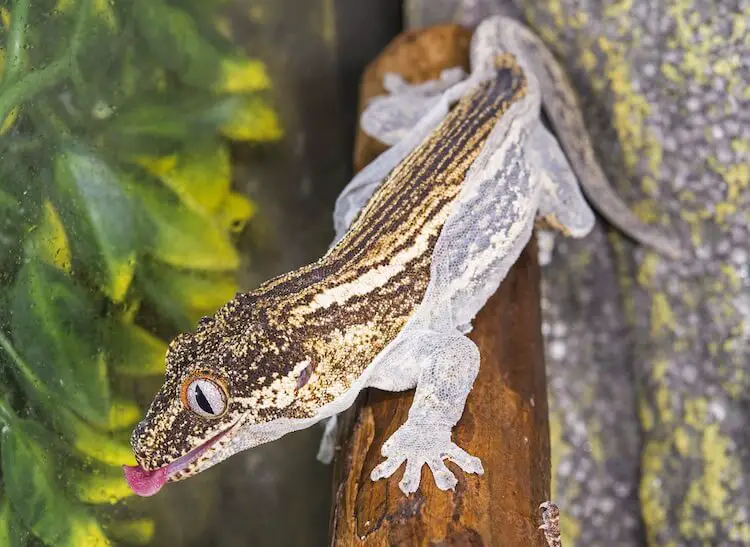
Due to deforestation, their natural habitat is considered to be in danger. The natural environment of this reptile is very tropical, warm and moist. They typically live in low canopies and shrubs.
Like most Rhacodactylus species, it is very important that these reptiles live in warm, humid environments. They should also have enough space to climb and will be better off living individually or in pairs of the opposite sex.
Gargoyle Gecko’s Tank and Enclosure
The best enclosures for these Geckos are made out of plastic or glass. Screen tanks might do the trick if you are responsible for monitoring the humidity levels so that your reptile doesn’t become dehydrated:
- A tank for Gargoyle hatchlings should be no less than 5 gallons in size.
- Juveniles should be housed in 10-gallon tanks.
- Once they mature at about 18 months, the Geckos should be transferred to a larger tank of at least 20 gallons.
The best tank will have hiding places and jumping opportunities (they will also benefit from a basking spot).
This can be achieved with the incorporations of plants (real or fake), tubes and branches. Creating a stimulating environment for your reptile is key to keep them environmentally enriched.
Lighting
Gargoyle Geckos are nocturnal and should not have any light during the night so as to not to disturb their natural rhythm.
A low wattage incandescent bulb can be used as a basking light but should only be placed on one side of the cage to create a temperature gradient. UVB light is also recommended for the synthesis of vitamin D3 but is not required if your lizard is fed a nutrient-rich diet.
Temperature is one of the most vital requirements for Gargoyle Geckos. That is why it is important to create a temperature gradient in their housing so they are able to moderate their temperature by having a hot and cool side of the tank.
Heating and Temperature
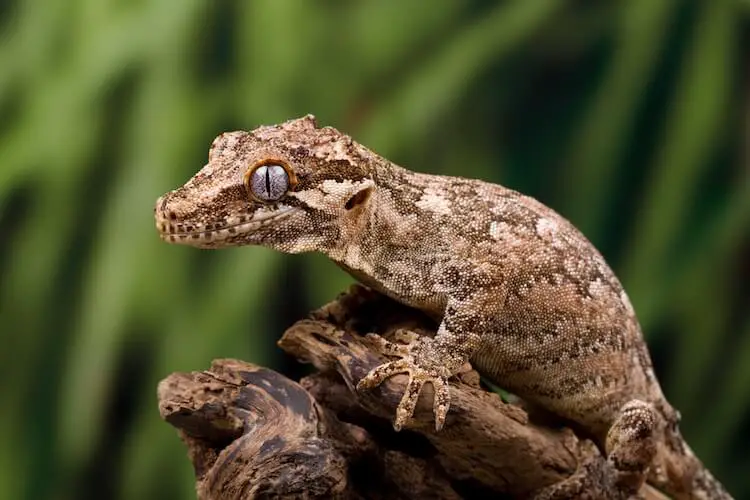
Basking lights or ceramic heat emitters should be the main heat source. Screen tops will allow the best exposure for the low wattage basking bulbs.
Gargoyle Geckos thrive in temperatures of 77-84 degrees Fahrenheit. They will need appropriate lighting (e.g. UVB) or heat emitters (e.g. ceramic) to achieve this.
Exceeding 84 degrees Fahrenheit will stress out your lizard and they may seem jumpier than usual, aggressive and frequently gape their mouths.
Humidity levels should be kept between 50-70%, and tanks should be misted once or twice a day. Hygrometers and thermometers will aide in monitoring these levels.
To increase the humidity in a tank, you should mist it frequently and keep a clean water bowl available. Ensure you wait for the humidity level to drop below 50% and then spray it to avoid the growth of mildew. Misting the cage can be accomplished with a humidifier or spray bottle.
Gargoyle Gecko Substrate
Peat moss is the best substrate to keep in your Gargoyle’s enclosure because it keeps the humidity level high.
This should be spot cleaned every day and changed at least once a month. Bioactive substrate works wonderfully in keeping a clean environment but might be a little more expensive than peat.
| Tank Tips | |
|---|---|
| Tank Type | Plastic or glass |
| Lighting | Basking light (low wattage incandescent bulb) |
| Best Substrate | Peat moss is the most popular |
Feeding A Gargoyle Gecko
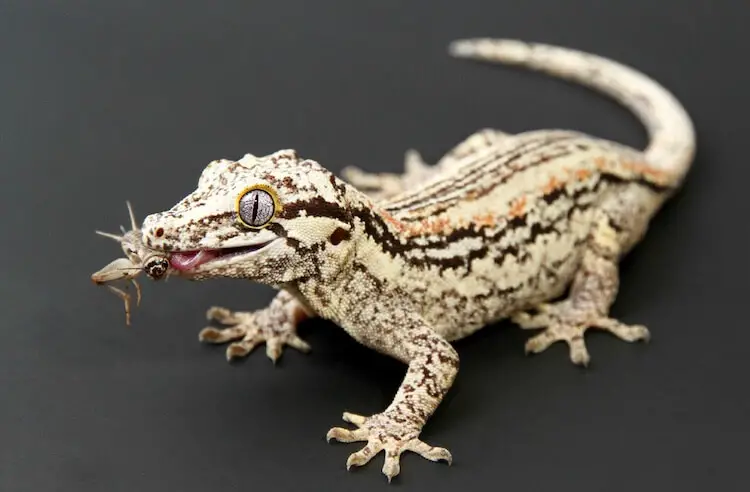
In the wild, these reptiles live off of insects, nectars, fruits and the occasional pinky mouse. But are omnivores they get most of their nutrients from fruits.
To keep a balanced diet, your Gecko really only needs to eat a fruit-mix. Supplements should be added to other foods such as insects (they should be coated with calcium and vitamin D3 supplements to meet their needs).
There are many commercial feeds that will keep your reptile happy. Crested Gecko foods will work wonderfully for these lizards as well. You can even try feeding a human baby food that is made from fruit (as long as you add calcium and vitamin D3 supplements).
These Geckos can be fed live insects, however it is not mandatory and they may not always accept it. Hatchlings require the same diet as adults and juveniles; however, it is recommended that they eat some insects to stimulate growth. They should eat insects twice a week and should be fed regular fruit-mix four times a week.
Adult Gargoyle Geckos don’t require any insects but should eat their fruit mix 2-3 times a week. The mixes should be made out of tropical fruits that are high in calcium such as papayas, figs, and black berries.
The amount of mix you should feed your Gecko depends on the individual but they should eat enough to maintain at a healthy weight of between 60-80 grams.
Though they may not always drink out of it, a water dish should still be placed in their tank to regulate humidity levels. The water bowl should be cleaned weekly to avoid the growth of bacteria.
A Gargoyle Gecko will tend to lick water droplets off of decorations so you should mist the enclosure frequently and when they’re awake.
| Diet Summary | |
|---|---|
| Vegetables | 0% of diet |
| Insects | 0% of diet |
| Fruits | 100% of diet |
| Supplements Required | Vitamin D3 and calcium every time they are fed baby food or insects. |
How To Keep Them Healthy
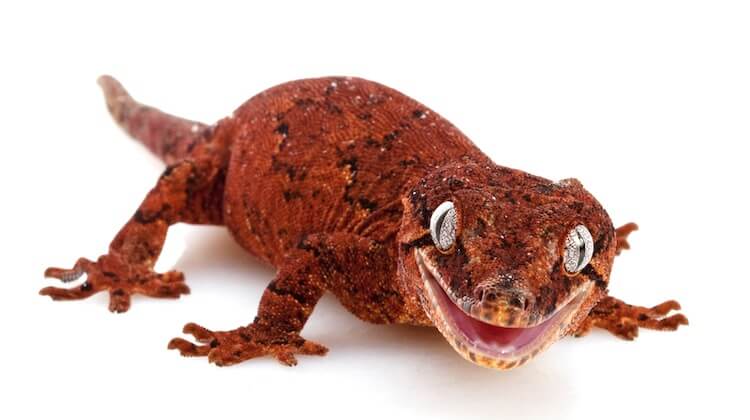
Gargoyle Geckos are known to a be a very docile and friendly lizard. However, like most other animals, they have to learn to trust you before they can become completely comfortable.
The first handling sessions should be only a few minutes long and should take place every other day. Gradually, you may increase the time and frequency until your reptile is completely settled-in.
With a younger hatchling or juvenile, you should make sure your surroundings are cushioned in case they jump. They may bite if they are scared therefore it is very important to wash your hands before and after contact.
Bathing
Gargoyle Geckos should only be bathed when dirty or they have trouble shedding their skin.
To do this, start by obtaining a small container and punch small holes in the lid (this will let some humidity escape during bathing).
Fill the container with room temperature water until it is just enough to cover your lizard’s toes (warm or hot water is not acceptable as it may hurt them). Place your Gecko inside the container and cover with the lid. Let them bathe for between 10 to 15 minutes.
If your lizard has retained skin, you may try to remove it with a Q-tip or tweezers.
Tank Cleaning
To keep their housing clean, feces and shed skin should be removed daily. Food and water dishes should also be changed every day and the substrate should be spot cleaned.
Once a week, you should wipe down the interior of the tank with suitable disinfectant using a 1:10 ratio. You’re going to want to do a deeper cleanse every 3 to 4 months. A deeper clean will include washing everything in the enclosure and changing the peat moss (or whichever substrate you chose).
Make sure your Gargoyle Gecko is removed from their cage before you start cleaning and his tank is completely free of fumes before putting him back in.
Feces should be cleaned every day, healthy waste is dark brown and well-formed.
| Signs They Are Healthy | Sickness Symptoms |
|---|---|
| Clear eyes | Sudden weight loss |
| Stocky | Fewer droppings |
| Eats regularly | Lethargy |
| Alert | Sunken eyes |
Gargoyle Gecko Lifespan
A Rhacodactylus Auriculatus can live for up to 20 years in captivity. Some common issues include difficulty shedding, metabolic bone disease, parasites and stress. If you feed a healthy diet and follow our humidity guidelines you can help to avoid these health issues.
Gargoyle Gecko Behavior and Temperament
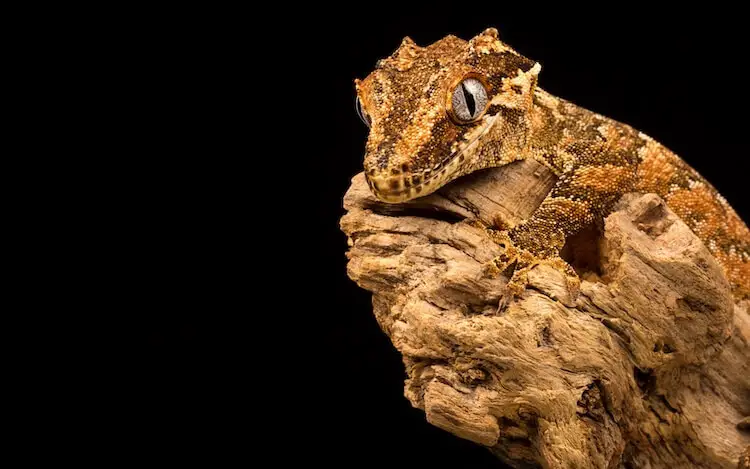
In their native habitat, they will most likely be found sheltered in trees or undergrowth.
They are solitary creatures and will display aggression towards others of its kind. That is why it is best to keep these lizards housed individually. Sometimes, males can be paired with one or more females as long as you keep a close watch on them.
These lizards don’t usually get along with other types of lizards either, so it is safest to house them individually. They are naturally territorial and will most likely try to fight any animal in their tank.
Gargoyle Geckos communicate with each other through low growls or squeaks. They may also display different tail movements.
In captivity, these guys will enjoy climbing and hiding in different areas throughout the tank. They will prefer to spend time in a basking spot due to their requirements of higher temperatures.
These reptiles are known for their passive temperament. Once they learn to trust their owner, they will allow frequent handling. However, they may bite if they are still not used to human interaction. Their bites are usually quick nips but might draw some blood because of their sharp teeth.
Because Gargoyle Geckos come from a tropical habitat, they do not brumate or hibernate.
Appearance
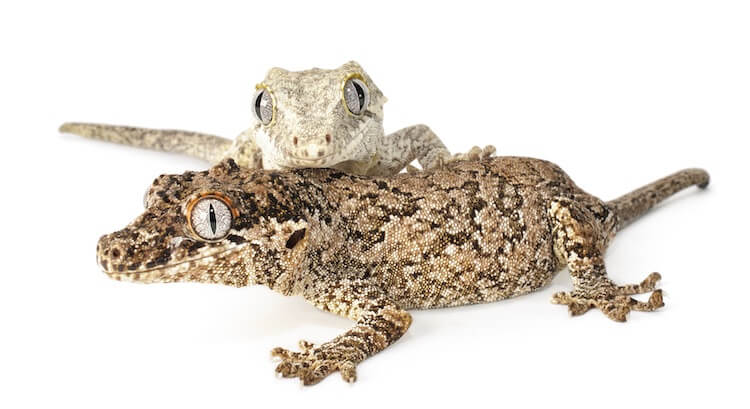
Determining the gender of your lizard might be tricky because both male and females may display a slight bulge at the base of their tail.
Sex determination is easier when geckos are sexually matured (about 18 months) because then you can just look for femoral pores near their vent. The presence of these pores will mean that your Gecko is a male.
Gargoyle Gecko Size
Hatchlings will be a few inches long and will weigh about between 2-3 grams when born. The average age of sexual maturity is 18 months. As adults, they will be between 8 to 10 inches and will weigh anywhere from 60-80 grams.
Slow growth rates usually mean your Gecko’s diet lacks in calcium or other essential nutrients (e.g. vitamin D3).
Colors
The Gargoyle Gecko is known to come in a variety of colors such as:
- Green
- Brown
- Yellow
Individual Geckos will have differing stripes, spots or patterns. Some Gargoyle Gecko morphs are becoming increasingly available due to breeders working to create exciting color variations such as red, orange and white.
How To Sex A Gecko
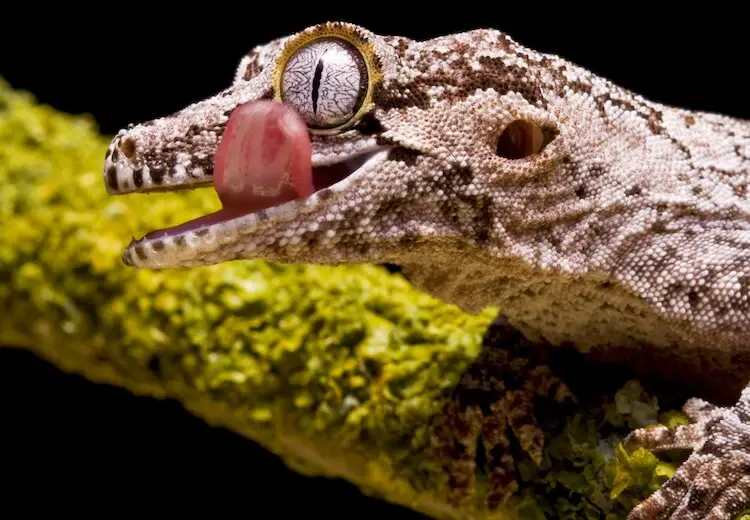
Before breeding a Gargoyle Gecko with another, you should confirm that they have reached sexual maturity. This will make the sexing process easier and safer.
You can introduce them in an enclosure with a glass screen to initially keep them seperate them (in case they feel hostility). If their body language shows that they are interested (e.g. trying to get closer to each other and communicating you should remove the screen and let nature run its course.
Eggs will appear 2-3 weeks after mating. The female will usually lay two eggs every 4-6 weeks and may have up to 10 lays. Hatchlings will hatch after 70-90 days.
The best temperature to keep the eggs is 75 degrees Fahrenheit and higher temperatures will produce more males.
Hatchlings
Baby hatchlings have the same basic requirements as adults. They need the correct diet and should be misted frequently. They can eat the same diet as adults, but will also need dusted insects to help them grow. They will only weigh about 3 grams after hatching.
How Much Does A Gargoyle Gecko Cost?
These reptiles are widely popular and available. When purchasing one, you should look for a reputable breeder and make sure the Gecko looks in good health before purchasing.
The price of a Gargoyle Gecko may vary depending on where you buy them and their color patterns, but most retail for between $200-$500 USD.
Care Guide Summary
| Pros | Cons |
|---|---|
| Their diet doesn’t require any insects making them easy to feed. | They have very sharp teeth. |
| They are very tame and amusing to watch. | They don’t like having cage mates, thereby requiring an individual tank. |
| Easily socialized to enjoy handling. | Sexing can be difficult so many amateurs purchase hatchlings. |
The Gargoyle Gecko is often compared to Crested and Leachianus Geckos. While Crested and Gargoyles are the most similar, Leachies are the most complex of the three.
One of the many reasons why owners appreciate these lizards is because they have such easy-to-meet requirements, making them easy to care for.
Their temperament also plays a huge role in why they are so popular. They are very quick to adjust to being handled and make perfect reptile for beginners.
These reptiles are docile, fun to watch and come in many different colors; it’s no wonder why so many people want them.
The name “Gargoyle ” may give off the wrong impressions about these lizards. The only thing scary about them is their ability to steal the hearts of hundreds of reptile lovers!
Let us know what you think about them below.

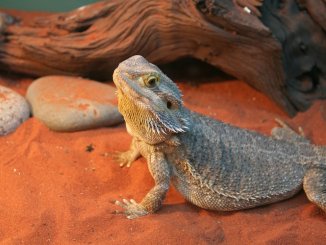
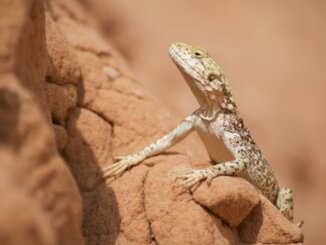
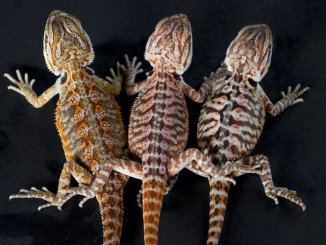
How do you know if your gecko is obese or dehydrated?
Hi Gabriela, what is his weight and does he have a shallow water bowl in his cage?